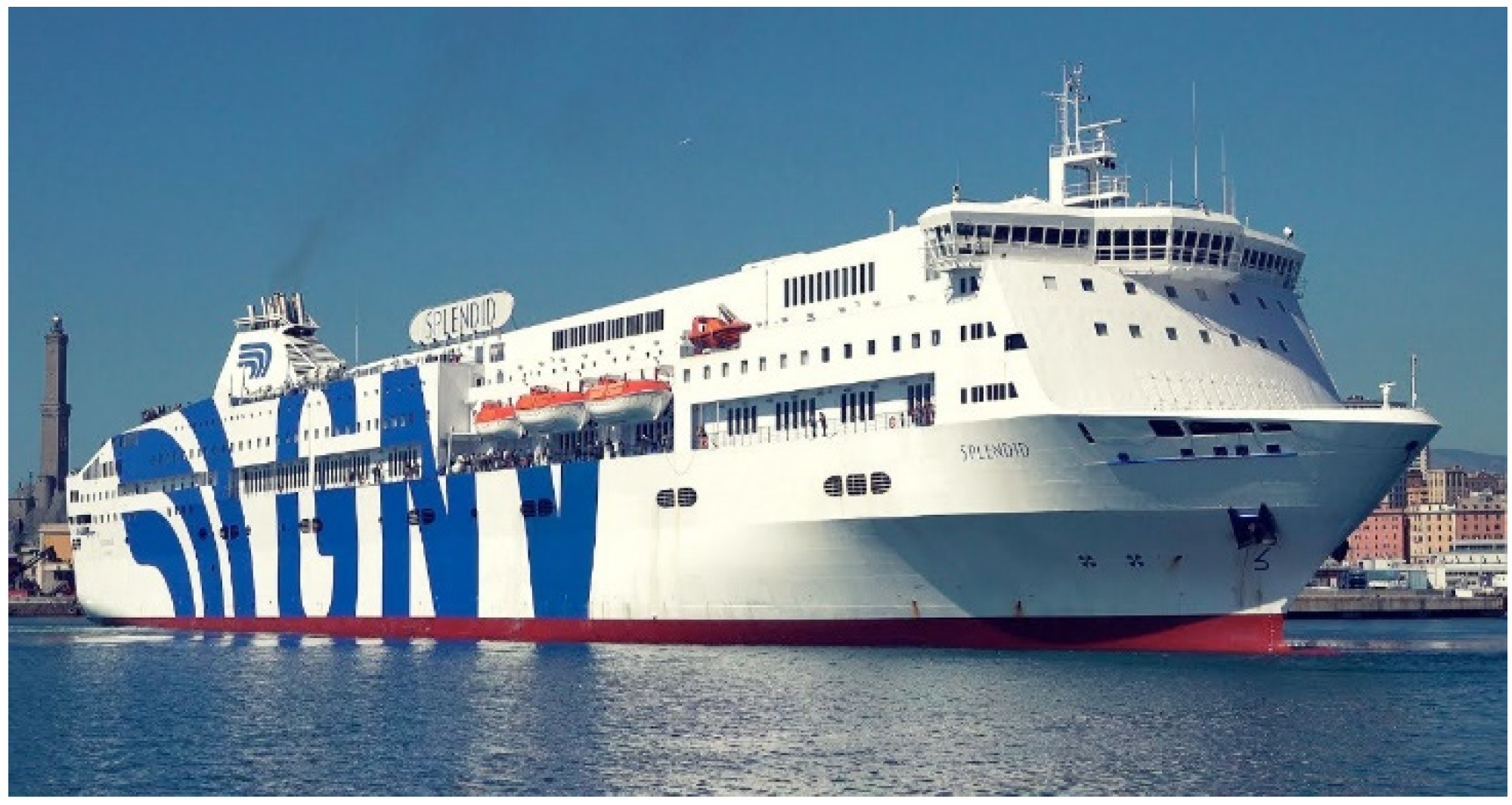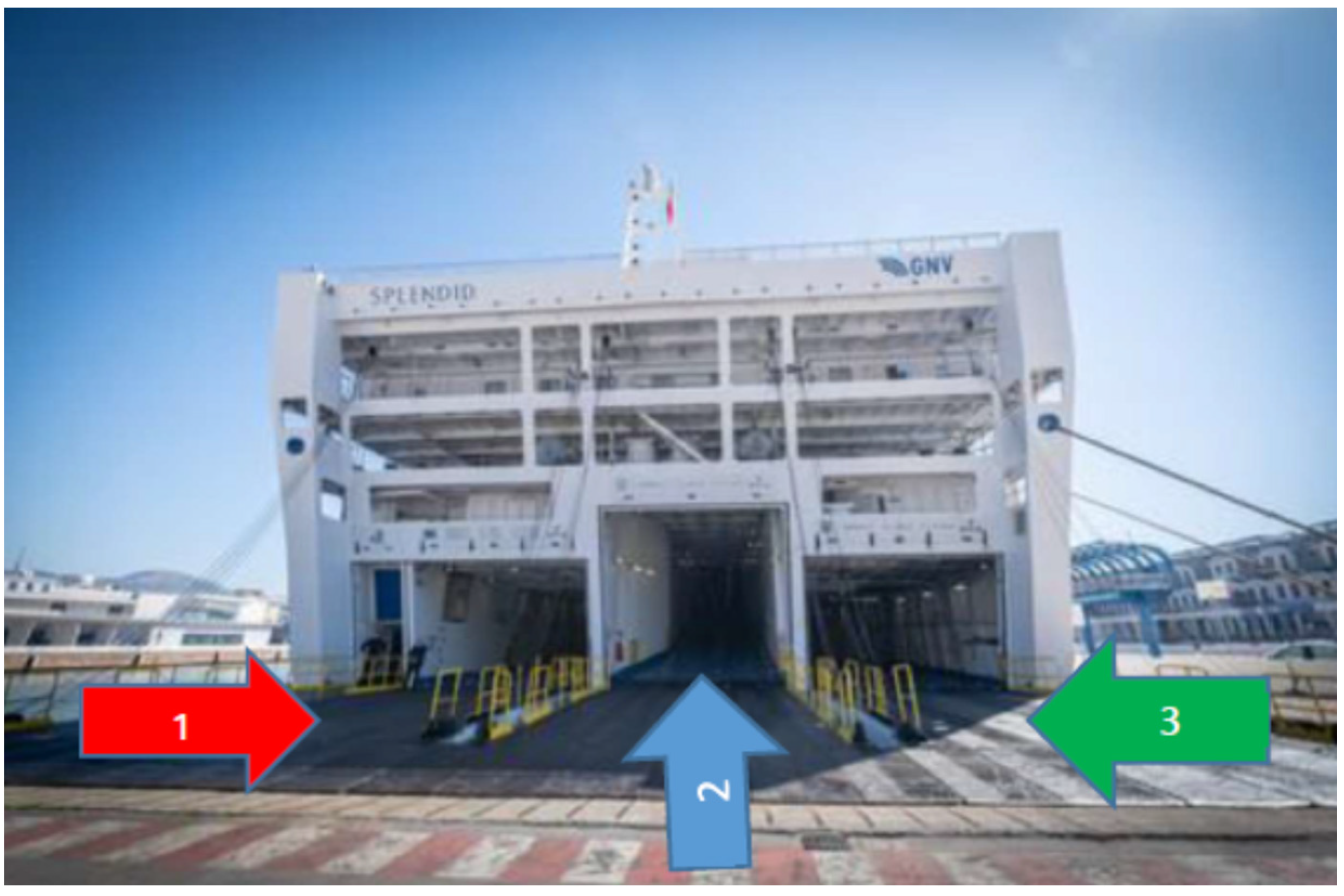Transformation of a Ferry in a COVID-19 Ship Hospital: Crew Occupational Safety and Health Issues According to the Experience of Liguria Public Health Port Authority †
Abstract
:1. Introduction
2. Material and Methods
3. Results
4. Discussion and Conclusions
Author Contributions
Funding
Institutional Review Board Statement
Informed Consent Statement
Data Availability Statement
Acknowledgments
Conflicts of Interest
Appendix A. Plan of Deck 7—Hospital Area



| Issues | Actions |
|---|---|
| Access to the ferry | Pre-triage of patient ashore. Identification of three separated access pathways (see Figure 2). One RED right-side stern gangway further divided into (a) water side: healthcare staff and clean materials; (b) internal side: patient ambulances and dirty material. Two BLUE central gangway: ship and pantry supplies. Three GREEN left-side stern gangway: crew and external staff for technical interventions. |
| Air handling and ventilation | Equipment to avoid short circuits between safe and unsafe areas. Air treatment units separated for vertical zones. Additional extraction system from the patient cabins to create negative pressure. |
| Management of waste and bed linen | All waste from deck 7 was considered hazardous medical waste. Before leaving the hospital area, the waste containers were decontaminated externally with a chlorine solution. Dirty bed linen was placed in double bags (inner biodegradable). Waste and dirty bed linen were removed by specialized companies. |
| Sewage | Sewage was discharged from the ship by a barge and decontaminated with chlorine. |
| Therapeutic oxygen | Supplied by tanks located ashore in the port area and was not onboard. |
| Issue | Action |
|---|---|
| New crew occupational risks | Revision of the risk assessment report. Identification and replacement of four crew members who were classified as high-risk regarding COVID-19 due to pre-existing conditions. |
| Separation of hospital area from other ferry areas | Bulkheads. Separated pathways. Clear signage. |
| Preparation of meals | Meals prepared in ferry galley. Flood-packaged in a disposable single-portion tray. Transport from the galley to the hospital by trolleys in a lift without an operator. The distribution to patients was carried out by car staff. Disinfection of trolley. |
| Mess | The health staff area was separated from the crew area. |
| Training and education | Crew had periodic training on the infective risks of COVID-19 and on the proper use of specific PPE. |
| Hospital area maintenance | Intensive training for the seven crew members of the onboard maintenance staff (the only crews authorized to enter the hospital area). Maintenance operations were performed in the absence of patients whenever possible. Donning and doffing PPE were performed under the direct supervision and assistance of healthcare staff. |
| Ship safety rules as per SOLAS for emergencies such as fire onboard, man overboard, abandon ship | Revision of the muster list. Emergency instructions to healthcare staff. New training for crew in charge of safety in the hospital area. |
| Epidemiological surveillance | Self-assessment of the crew’s temperature and COVID-19 symptoms two times a day. In case of symptoms or temperature > 37.5 °C, the crew immediately isolated in the cabin and used a PCR swab test. Swab and pre-triage stations were located on the pier ashore |
Publisher’s Note: MDPI stays neutral with regard to jurisdictional claims in published maps and institutional affiliations. |
© 2022 by the authors. Licensee MDPI, Basel, Switzerland. This article is an open access article distributed under the terms and conditions of the Creative Commons Attribution (CC BY) license (https://creativecommons.org/licenses/by/4.0/).
Share and Cite
Campagna, A.; Cremonesi, P.; Russo, R.M. Transformation of a Ferry in a COVID-19 Ship Hospital: Crew Occupational Safety and Health Issues According to the Experience of Liguria Public Health Port Authority. Med. Sci. Forum 2022, 13, 26. https://doi.org/10.3390/msf2022013026
Campagna A, Cremonesi P, Russo RM. Transformation of a Ferry in a COVID-19 Ship Hospital: Crew Occupational Safety and Health Issues According to the Experience of Liguria Public Health Port Authority. Medical Sciences Forum. 2022; 13(1):26. https://doi.org/10.3390/msf2022013026
Chicago/Turabian StyleCampagna, Antonello, Paolo Cremonesi, and Rosa Maria Russo. 2022. "Transformation of a Ferry in a COVID-19 Ship Hospital: Crew Occupational Safety and Health Issues According to the Experience of Liguria Public Health Port Authority" Medical Sciences Forum 13, no. 1: 26. https://doi.org/10.3390/msf2022013026
APA StyleCampagna, A., Cremonesi, P., & Russo, R. M. (2022). Transformation of a Ferry in a COVID-19 Ship Hospital: Crew Occupational Safety and Health Issues According to the Experience of Liguria Public Health Port Authority. Medical Sciences Forum, 13(1), 26. https://doi.org/10.3390/msf2022013026






